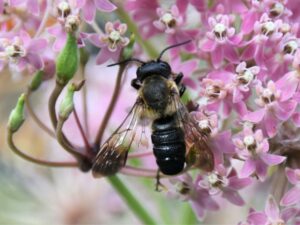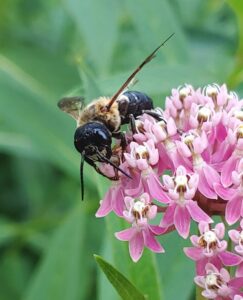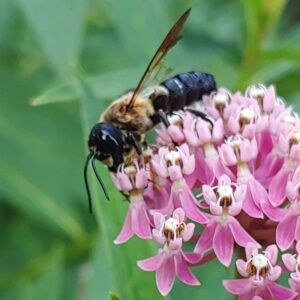Note: Most links leave to external sites.
Howdy, BugFans,
BugFan Freda found and photographed this awesome bee in her pollinator garden in August. It’s a distinctive bee, and it has an interesting story.
The Sculptured resin bee is sometimes called the Giant Asian resin bee, but there are resin bees that are larger, and it’s not just in Asia anymore. It’s in the family Megachilidae – the Leafcutter, Mason, Resin, Mortar, Sharptail, and Woolcarder bees.
Megachilids tend to be sturdy, medium-sized, mostly solitary bees that carry pollen in a mat of hairs called a scopa on the underside of their abdomen rather than on their legs like honey and bumble bees. They make egg chambers for their eventual young in pre-existing holes in the ground or in wood or other materials, and, depending on what group they’re in, they line the tunnels and seal the chambers with bits of leaf, plant resin, mud, or plant fibers (except for the Sharptail bees, Cuckoo leafcutter bees in the genus Coelioxys, which parasitize the nests of their Megachilid sisters). Adults eat pollen and nectar, and they provision their egg chambers with pollen. In many ways, the modus operandi of the Sculptured resin bee is similar to that of other family members.
Sculptured resin bees (Megachile sculpturalis) are big/“giant” bees (females measure about an inch and males are smaller) with elongated bodies and with big jaws that they use to collect plant resins (Megachile means “large jaws,”). Males have a yellow moustache on their face. When they’re sitting on flowers, they hold their wings out to the sides in a “V.” According to one source, the “sculptured” part refers to the head.
They’re big and they look dangerous, but males can’t sting and although females can, they’d rather flee than fight (although one source mentioned that he was bitten rather sharply when he handled one, so…..don’t).
They don’t come from here. They’re native to Japan and parts of eastern Asia, and they arrived on our shores (North Carolina), probably in wood, in 1994. They expanded their range to Alabama (1999), Canada (2002), Wisconsin (2004), Maine and Kansas (2008), and now they’re found in most states east of the Mississippi and a few that are west. They’ve also found their way to Europe. They like temperate zones, and researchers believe that they are likely to continue expanding throughout them. Ecologists list their status as “adventive” – non-native and present but not established.

The Megachilids are important pollinators, and Sculptured resin bees are no exception. Like other Megachilids, Sculptured resin bees are (Cool Science Word #1) “polylectic” – they collect pollen from a wide variety of flowers (43 species in the US).
Male Sculptured resin bees create territories and chase other males out of them. About the genus Megachile, bugguide.net says “The males of most species have enlarged light-colored front legs with a fringe of hairs and with odor glands. They use these features during mating. They partially cover the female’s eyes with the hairy legs and the odor glands are placed close to the female’s antennae.”

Sculptured resin bees are (Cool Science Word #2) a xylophilous (wood-loving) bee. Females create brood chambers in existing holes and crevices because although her large jaws are great for collecting resin and sap, they’re not so great for excavating in wood. The cells are formed from wood particles, mud, and plant resin and filled with pollen, and when she’s satisfied with the job, she lays an egg on the pollen, seals the cell, and starts making another, often constructing 8 or 10 cells per tunnel. The outside entrance to the tunnel may be sealed with a resin or mud cover. Even though she is a solitary bee, she will tolerate other bees nesting nearby. Her larvae feed in their cells throughout winter, pupate in them the following spring, and emerge in summer.
So – is the Sculptured resin bee a good thing or a bad thing?
Initial reactions were, “Hey – neat bee; it doesn’t seem to be bothering anything,” but any alien species has, of course, the potential to impact native species, whether through competition or spreading disease. Sculptured resin bees can be hard on the flowers they visit; there are reports of the bee damaging flower petals while foraging for pollen and nectar in a way that may make it harder for native bees to pollinate them.
Yes, they are pollinators, but researchers have noted that, like many non-native pollinators, they visit native plants, but they prefer non-native plants that hail from their areas of origin (one of the plants they pollinate in the South is Kudzu).
And then there are the nest tunnels. Sculptured resin bees mostly use deserted tunnels, but not always. They’re known to evict Eastern carpenter bees from their nest tunnels rather aggressively and then to redecorate the brood chambers for their own eggs. There’s a potential for similar conflict with any bee that makes a similar-sized tunnel, and they can monopolize bee hotels (some experts recommend destroying Sculptured resin bee larvae in bee hotels). One source noted that they have been observed killing honey bees.
Time will tell.
On a Lepidopteran note, it’s Wooly Bear season. Here’s the wooly bear BOTW, and a link to this year’s wooly bear celebration in Banner Elk, NC.
The BugLady
